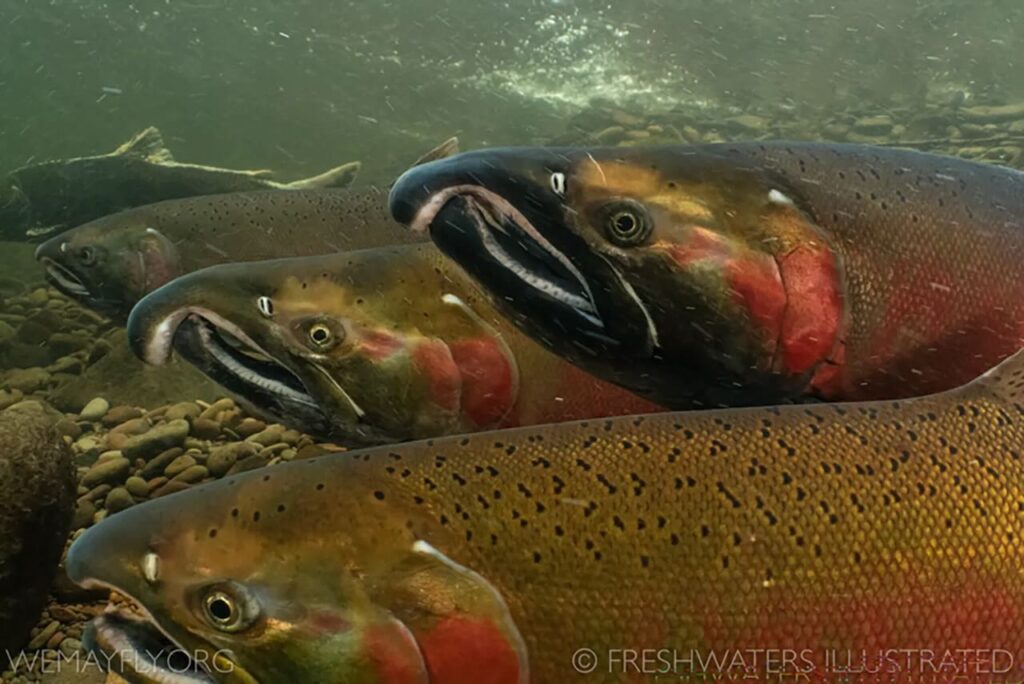
by: Native Fish Society McKenzie River Steward Dave Thomas
You are likely aware of recent reports of Coho salmon in our beloved McKenzie. Generally, we think of the McKenzie as a sanctuary for Spring Chinook salmon and indeed this run is protected under the endangered species act. So, what are Coho doing encroaching on Chinook waters? (spoiler alert, we don’t know).
First some background on Coho in the Willamette Basin. These species seem to have been endemic to the Willamette above Willamette Falls, at least since the 1950’s when ODFW started a stocking program. However, there are some reports of earlier occasional passages of Coho above the Falls, probably due to unusually high-water flows. The stocking program ended in 1996. Since then, until 2022, an average of eleven thousand Coho entered the river each year in the late Fall. Almost all of these fish spawned in the Western drainages of the Upper Willamette. It is believed that this species of salmon prefers the warmer waters and lower flows of these habitats, compared with the colder, higher-flowing eastern rivers.
So, what changed? In the Fall of 2023 approximately 28,000 Coho passed Willamette Falls and 50+ of these passed above Leaburg Dam. There are also reports of Coho in the Santiams, but precise counts are not available. In response to the availability of these fish, ODFW issued a temporary regulation allowing harvest of Coho wherever salmon harvest was allowed in the Willamette system.
In 2024, ODFW was ready to monitor the Coho invasion and indeed, between late September and early November more than 52,000 Coho passed above Willamette Falls, about five times the number we had come to expect. However, the number of Coho passing Leaburg Dam was one! In anticipation of a Coho fishery in the Upper Willamette like 2023, ODFW again issued a temporary regulation allowing Coho harvest.
Now in 2025, we await the Fall counts of Coho fish passage at Willamette Falls. There is speculation that the recent increase numbers in 2023 and 2024 was due to improved ocean productivity. While this may be the case, the current state of modeling does not allow for forward-looking quantitative estimates of particular species, much less individual runs of species. Regardless of the number of fish passing the Falls, we still have the apparent anomaly of higher number of Coho passing the Falls in 2024, but the number of Coho passing Leaburg Dam from 50+ to 1. However, in anticipation of what might happen with Coho numbers in the Willamette Basin, ODFW intends to make the temporary Coho harvest a permanent part of Willamette Basin fishing regulations.Given our current lack of understanding of the processes underlying the movement of these fish, a variety of futures seem about equally possible. That is, the numbers of Coho may drop back to something like the 11K we are used to seeing, or, for instance, Coho expanding their rang throughout the Willamette basin and possibly even displacing Winter Steelhead and Spring Chinook salmon. This will certainly make watching the Falls fish counts more interesting than usual.




Sounds like a radio telemetry study is needed, marking/implanting fish at the falls.
Cameron:
An excellent idea. Something like this has been under discussion and if this Fall passage number and the range expansion to the McKenzie continues we will needbetter data. For instance, where Coho are going in the tributraries and what impact might they may have on the protected salmon and steelhead runs of the